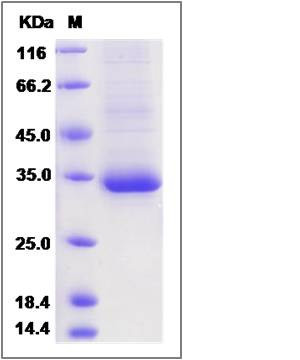Human MSLN / Mesothelin Protein (His Tag)
Mesothelin,MPF,SMRP
- 100ug (NPP2349) Please inquiry
| Catalog Number | P13128-H08H |
|---|---|
| Organism Species | Human |
| Host | Human Cells |
| Synonyms | Mesothelin,MPF,SMRP |
| Molecular Weight | The recombinant human MSLN consists of 261 amino acids and predicts a molecular mass of 28.2 KDa. It migrates as an approximately 33 KDa band in SDS-PAGE under reducing conditions. |
| predicted N | Leu 37 |
| SDS-PAGE |  |
| Purity | > 90 % as determined by SDS-PAGE |
| Protein Construction | A DNA sequence encoding the human MSLN (Q13421-2) (Met1-Arg286) was expressed with a polyhistidine tag at the C-terminus. |
| Bio-activity | |
| Research Area | Cancer |Cancer immunology |Tumor-associated antigen |
| Formulation | Lyophilized from sterile PBS, pH 7.4 1. Normally 5 % - 8 % trehalose and mannitol are added as protectants before lyophilization. Specific concentrations are included in the hardcopy of COA. |
| Background | Megakaryocyte potentiating factor belongs to the mesothelin family. This family is comprised by several mammalian pre-pro-megakaryocyte potentiating factor precursor (MPF) or mesothelin proteins. Mesothelin is a glycosylphosphatidylinositol-linked glycoprotein highly expressed in mesothelial cells, mesotheliomas, and ovarian cancer, but the biological function of the protein is not known. Megakaryocyte potentiating factor is highly expressed in mesotheliomas, ovarian cancers, and some squamous cell carcinomas (at protein level). It interacts with MUC16 and potentiates megakaryocyte colony formation in vitro. Megakaryocyte potentiating factor is secreted by several mesothelioma cell lines and is frequently elevated in the blood of patients with mesothelioma. Measurement of this protein may be useful in following the response of mesothelioma to treatment. |
| Reference |
